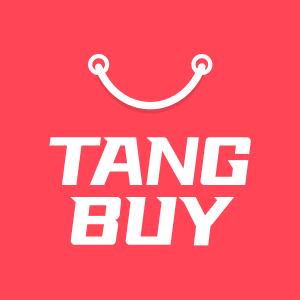What to Do If Wholesale Prices Are Unaffordable in 2025

You are not the only one who thinks wholesale prices are too high in 2025. Many people in wholesale see costs going up and profits getting smaller. Look at this new data:
Indicator | Change (Year-over-Year) | |
|---|---|---|
Final Demand PPI | +0.1% | +2.6% |
Finished Goods PPI | +0.4% | +1.5% |
Core PPI (excl. food & energy) | +0.1% | 3.0% |
Core Finished Goods PPI | +0.3% | +2.6% |
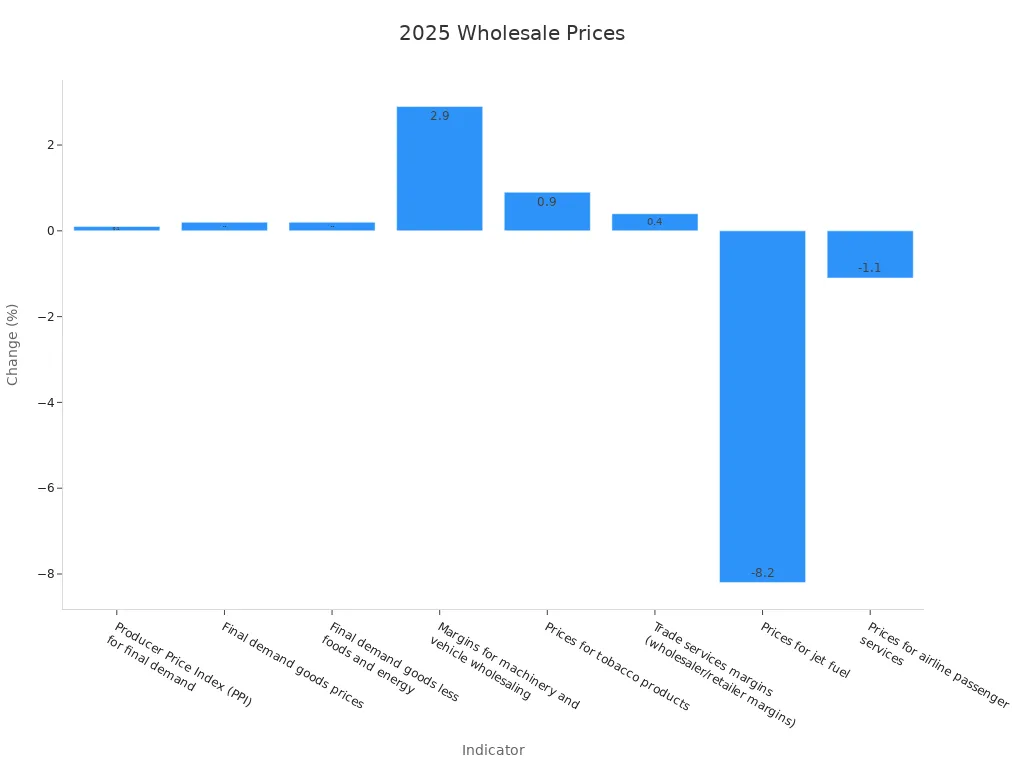
You can handle these wholesale price problems if you act quickly. Try to talk with your suppliers again, change your wholesale prices, or make your business run smoother. Stay alert and look at your choices before higher costs hurt your profits more.
Key Takeaways
Look at all your business costs closely to see where money is spent and find ways to save. Check how much profit you make on each product and change prices fast to keep your profits safe. Find products that make little profit and try to sell more items that make more money. Know the lowest amount you can sell to not lose money and set clear goals for sales. Talk with your suppliers to get better prices or deals and think about changing how much you order to save money. Look for new suppliers, try options from other countries, or use different products to get better prices and stay ready for changes. Use special pricing tools and study the market to set smart prices that fit your costs and what customers want. Tell customers about price changes in a clear way to build trust and keep them coming back.
Assess Impact

Review Costs
Start by looking at every cost in your business. You want to know where your money goes before you make changes. Costs in wholesale can shift for many reasons. Sometimes, high costs come from outside factors like tariffs or trade rules. Other times, they happen because suppliers face risks or have limited capacity. When suppliers can meet demand, prices and profits can go up with risk. If they cannot, prices may stay flat even if risks rise. You also need to think about hidden costs. These can include extra shipping fees, new taxes, or even changes in supplier behavior.
Tip: Make a list of all your costs. Break them into fixed costs (like rent), variable costs (like materials), and mixed costs (like utilities). This helps you see which costs change and which stay the same.
Fixed costs stay the same each month. They can strain your cash flow if sales slow down.
Variable costs change with how much you sell or make. These include raw materials and shipping.
Mixed costs have both fixed and variable parts. You need to track these closely.
Analyze Margins
Now, check your profit margin on each product. This tells you how much money you keep after paying all costs. If your costs go up but prices stay the same, your profit margin shrinks. That means less money for you.
A good wholesale profit margin usually falls between 15% and 50%. To keep your business healthy, you need to calculate wholesale prices that cover all your costs and leave room for profit.
Here’s a simple breakdown:
Amount ($) | Percentage of Retail Price | |
|---|---|---|
Wholesale Cost | 40 | 40% |
Profit Margin | 40 | 40% |
Operating Expenses | 20 | 20% |
Total Retail Price | 100 | 100% |
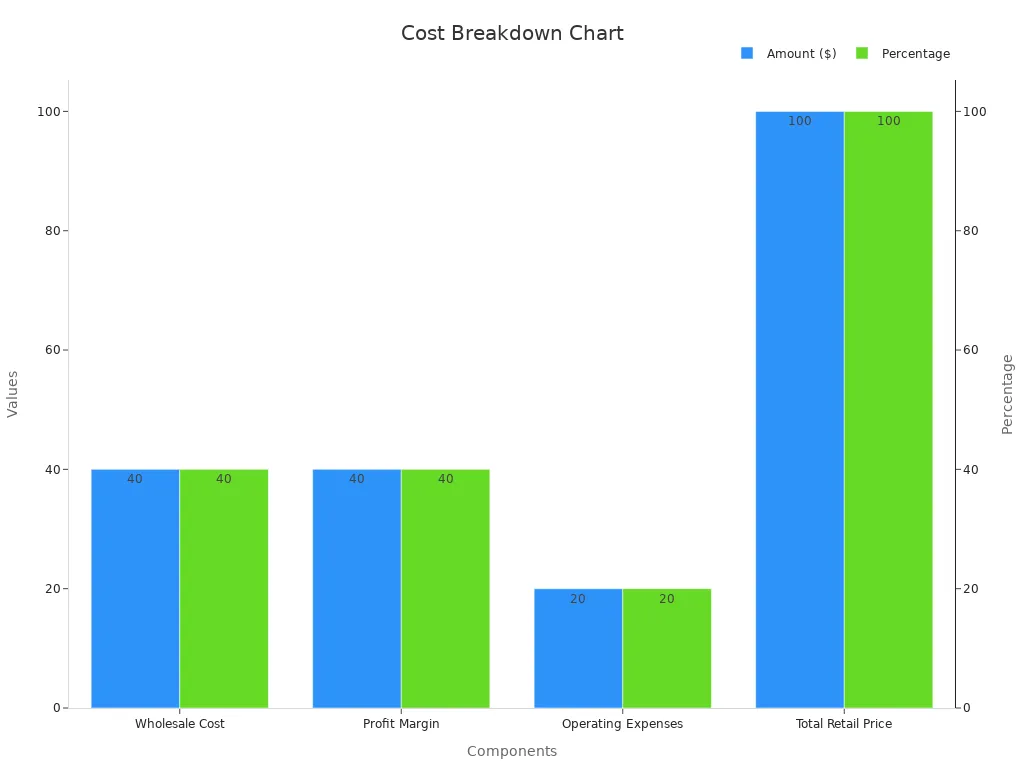
If you see your profit margin dropping, you may need to adjust your pricing. Use dynamic pricing tools to help you react fast. Static pricing models can hurt your profits when costs change quickly. Even a 1% improvement in realized price can boost your profits by up to 11%.
Identify Affected Products
Not every product feels the impact of high costs the same way. Some items have a strong profit margin and can handle a price increase. Others are more price-sensitive and may lose sales if you raise prices.
Go through your product list and mark which items have the lowest profit margin. These are the ones most at risk. Products with a higher wholesale profit margin give you more flexibility.
Focus on products where you can calculate wholesale pricing to keep your profits steady.
Watch for items that use materials with rising costs or face new tariffs.
Use analytics to spot which products are losing margin fastest.
Note: When you calculate wholesale prices, always include overhead like rent and marketing. This keeps your profit margin healthy and your business strong.

Break-Even Points
Do you know your break-even point? If not, now is the perfect time to figure it out. The break-even point tells you how many units you need to sell to cover all your costs. After you reach this number, every sale brings in profit. When wholesale prices go up, your break-even point changes. You need to check it often.
Why does the break-even point matter?
If you do not know your break-even point, you might sell at a loss without realizing it. High costs can sneak up on you. You want to make sure you are not working hard for nothing.
Tip: Always update your break-even point when your costs or prices change. This helps you stay ahead.
How to Calculate Your Break-Even Point
You do not need to be a math whiz. Here is a simple formula:
Break-Even Point (in units) = Fixed Costs ÷ (Selling Price per Unit - Variable Cost per Unit)
Let’s break it down:
Fixed Costs: These do not change, like rent or salaries.
Variable Cost per Unit: This is what you pay for each item, including the new wholesale price.
Selling Price per Unit: This is what you charge your customer.
Example Table:
Item | Amount ($) |
|---|---|
Fixed Costs | 5,000 |
Variable Cost/Unit | 20 |
Selling Price/Unit | 35 |
Plug these numbers into the formula:
Break-Even Point = 5,000 ÷ (35 - 20) = 5,000 ÷ 15 = 334 units (rounded up)
So, you need to sell at least 334 units to cover your costs. Every sale after that is profit.
What Should You Do Next?
Check your break-even point for each product. Some products may need a higher price or lower cost to stay profitable.
Use your break-even point to set sales goals. If you cannot reach the number, you may need to drop the product or find a cheaper supplier.
Watch for changes. If your supplier raises prices again, update your numbers right away.
Note: If your break-even point jumps too high, do not panic. Look for ways to lower costs or raise prices. Sometimes, small changes make a big difference.
Knowing your break-even point gives you control. You can make smart choices, protect your profits, and avoid surprises. Keep this number handy. It is your best friend when wholesale prices go up.
Immediate Actions
Supplier Negotiation
If prices are too high, talk to your wholesale suppliers first. Start a conversation about your current deal. Ask if they can give you better terms or discounts. This is easier if you have ordered from them a lot. Many suppliers want to keep your business, so they may help you.
Try these ideas when you talk to suppliers:
Show sales and inventory data to prove you are a good customer.
Offer to buy more or sign a longer contract for a lower price.
Ask if you can get a discount for paying early or pay in different ways.
Mention competitor prices if you have proof.
Negotiations work best when you use facts. Some companies use supplier performance data to ask for lower prices or better service. If your supplier does well, you can agree on fair price changes based on the market. Long-term deals often have yearly price checks to keep things fair for both sides.
Tip: Keep a vendor scorecard. Track delivery times, product quality, and price changes. This helps you make smart choices when you negotiate.
You can also plan when to buy. If you know demand will go up soon, try to set prices early. Some companies save money by buying more before prices rise. This works well for things like furniture and building materials.

Adjust Order Size
You can sometimes save money by changing how much you buy. If you order more at once, you might get a volume discount. This means you pay less for each item. But you need to think about your storage space and cash.
Here are some ways to change your order size:
Buy more if you have room and money. Ask for a better price on bigger orders.
Buy less if you want to avoid having too much stock. This keeps your money free for other things.
Share an order with another business. You both get a discount without buying too much.
Many businesses use sell-through data to pick the best order size. When you track how fast things sell, you can order just enough. Studies show this helps you avoid extra costs and keeps your supply chain smooth. For example, a US drug company used forecasting and sell-through data to make better choices about prices and stock. This helped them react fast when wholesale prices changed.
Note: Always check your sales trends before making a big order. You do not want to get stuck with products you cannot sell.

Raise Minimum Purchase
If you sell to other businesses, you can set a higher minimum purchase. This means customers must buy more to get your wholesale price. Raising the minimum helps cover your costs and keeps your profit margin strong.
Here are some ways to do this:
Look at your current minimum order size. See if it still works with your new costs.
Tell your customers why you need to raise the minimum.
Give extra value, like free shipping or a bonus, for bigger orders.
Raising your minimum purchase helps you focus on your best customers. It also cuts down on small orders that do not make much money. This saves you time and money on packing and shipping.
Tip: If some customers cannot meet the new minimum, suggest they join with others or buy less often but in bigger amounts.
Taking these steps helps you stay ahead when wholesale prices change fast. Quick actions like negotiating, changing order sizes, and raising minimums can protect your profits and keep your business strong.
Prioritize High-Margin Items
When wholesale prices jump, you need to get smart about what you sell. Not every product brings in the same profit margin. Some items eat up your costs and leave you with little to show for your hard work. Others help you maximize profits with every sale. You want to focus on those winners.
Start by sorting your products by profit margin. Look at your sales reports and highlight the items that give you the highest return. These products usually have a strong wholesale profit margin and can handle price changes better than low-margin goods.
Tip: Use a simple table to compare your products. This helps you spot the best performers at a glance.
Product Name | Wholesale Cost | Selling Price | Profit Margin (%) |
|---|---|---|---|
Widget A | $10 | $25 | 60% |
Widget B | $15 | $22 | 32% |
Widget C | $8 | $18 | 56% |
You can see that Widget A and Widget C have a much higher profit margin than Widget B. If you want to maximize profits, put your energy into selling more of A and C.
Here’s how you can prioritize high-margin items:
Promote high-margin products first. Put them at the front of your store or website. Use email and social media to show them off.
Bundle low-margin items with high-margin ones. This can help you move slow stock while keeping your profit margin healthy.
Adjust your inventory. Order more of the products with a strong wholesale profit margin. Cut back on items that drag down your profits.
Train your sales team. Make sure everyone knows which products help you maximize profits. Give them tips on how to talk about these items with customers.
Sometimes, you may feel pressure to keep selling everything. But when costs rise, you need to protect your profits. Focus on what works. Drop or pause products that do not meet your profit margin goals. This keeps your business strong and ready for the next challenge.
Note: Review your product list every month. Wholesale prices can change fast. Stay alert and keep your focus on high-margin winners.
If you make these changes, you will see your profits improve. You will also have more cash to invest in new products or better deals with suppliers. Remember, your goal is to maximize profits and keep your business healthy, even when wholesale prices are tough.
Alternative Sourcing
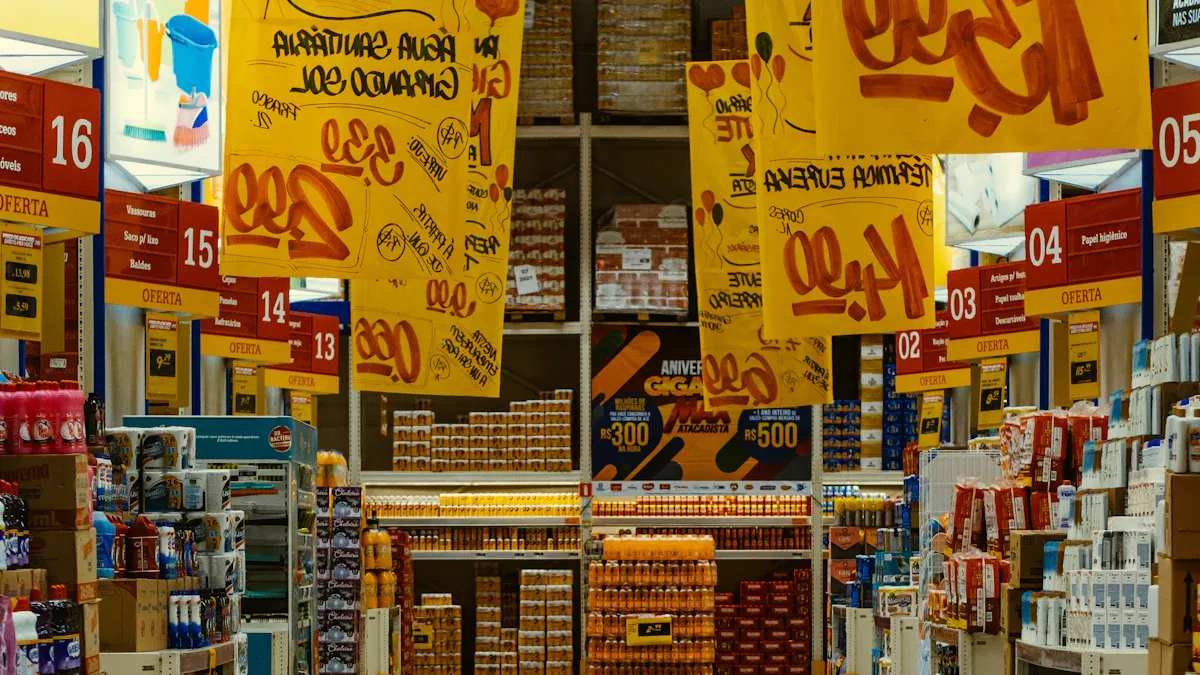

New Suppliers
You do not need to use the same suppliers forever. If prices are too high, look for new ones. Many businesses use search tools to find suppliers in other industries. These tools update every week, so you get new info often. You can search by product, location, or if they care about the environment.
You can check supplier ratings and how fast they deliver.
Some websites show if suppliers use eco-friendly materials.
Real-time data helps you see problems before you buy.
Companies make new partnerships and invest in suppliers to save money. They use digital tools like AI to find good deals and avoid supply chain issues. You can do this too when buying wholesale. Try a wholesale marketplace to compare prices and read reviews. This helps you avoid problems and keeps your business flexible.
Tip: Always check a new supplier’s history before you buy. Look for good reviews and on-time delivery.
International Options
Sometimes, the best prices come from other countries. Many businesses buy from places like Vietnam, India, or Mexico. These countries have lower prices and help you avoid high tariffs. US suppliers are also popular because they ship faster, even if they cost more.
Here’s what you should know:
Shipping costs and delivery times are important. US suppliers can ship fast.
International suppliers may be cheaper, but check quality and shipping time.
Many companies use third-party warehouses to get products faster.
Many retailers use both local and international suppliers. This helps them stay flexible and meet customer needs. When buying wholesale, always check the total cost, not just the price per item. Remember to add shipping, taxes, and possible delays.
Country | Shipping Speed | Price Level | Common Products |
|---|---|---|---|
USA | Fastest | Higher | Apparel, electronics |
Vietnam | Moderate | Lower | Textiles, shoes |
India | Moderate | Lower | Jewelry, home goods |
Mexico | Fast | Moderate | Auto parts, furniture |
Note: Always ask for samples before you buy from a new country. This helps you check quality and avoid problems.
Substitute Products
If your usual products cost too much, try substitutes. Substitute products help you keep sales steady when your main items are too expensive or out of stock. Many companies did this during the pandemic and other supply chain problems.
You can switch to a similar product if your main one is gone.
Some businesses use cheaper materials to make their products.
Substituting helps you keep customers when prices go up.
For example, a tire company used devulcanized silicone instead of regular silicone when supplies were low. This kept their business running and helped control costs. Studies show using substitute products can raise profits and make your supply chain stronger. You can also use this idea to test new products in your wholesale marketplace.
Try this: Make a list of possible substitutes for your best-selling items. Ask your suppliers what they can offer.
Trying new suppliers, looking at international options, and using substitute products can help you save money and keep your business running well. When you buy wholesale, stay open to new ideas and keep checking for better deals.
Dropshipping Models
Dropshipping can help you handle high wholesale prices in 2025. You do not need to buy products in bulk or keep them in your warehouse. Instead, you sell items on your website or store, and your supplier ships them straight to your customer. This model can lower your risk and save you money when prices go up.
Here’s how dropshipping works:
You list products for sale online.
A customer places an order with you.
You send the order to your dropshipping supplier.
The supplier ships the product directly to your customer.
You never touch the product. You do not need to worry about storage or shipping. This can help you stay flexible when wholesale prices change fast.
Tip: Dropshipping lets you test new products without spending a lot of money upfront. If something does not sell, you can remove it from your store with no big loss.
Pros and Cons of Dropshipping
Let’s look at the good and bad sides of dropshipping:
Pros | Cons |
|---|---|
Low upfront costs | Lower profit margins |
No need for storage space | Less control over shipping |
Easy to add new products | Harder to manage returns |
Flexible and scalable | More competition |
You can see that dropshipping has some trade-offs. You save money and avoid big risks, but you might make less profit on each sale. You also need to trust your supplier to ship on time and keep products in stock.
How to Start Dropshipping
Ready to try dropshipping? Here are some steps to get started:
Find a reliable dropshipping supplier. Look for good reviews and fast shipping.
Use a wholesale marketplace to compare suppliers and products. This helps you find the best deals and avoid scams.
Add dropshipping products to your store. Start with a few items and see how they sell.
Watch your sales and customer feedback. Make changes if you see problems with shipping or product quality.
Note: Always order a sample for yourself before you sell a new product. This helps you check quality and shipping speed.
Dropshipping can help you stay in business when wholesale prices are high. You can keep your store full of products without spending a lot of money upfront. If you want to stay flexible and lower your risk, dropshipping is a smart option to try.
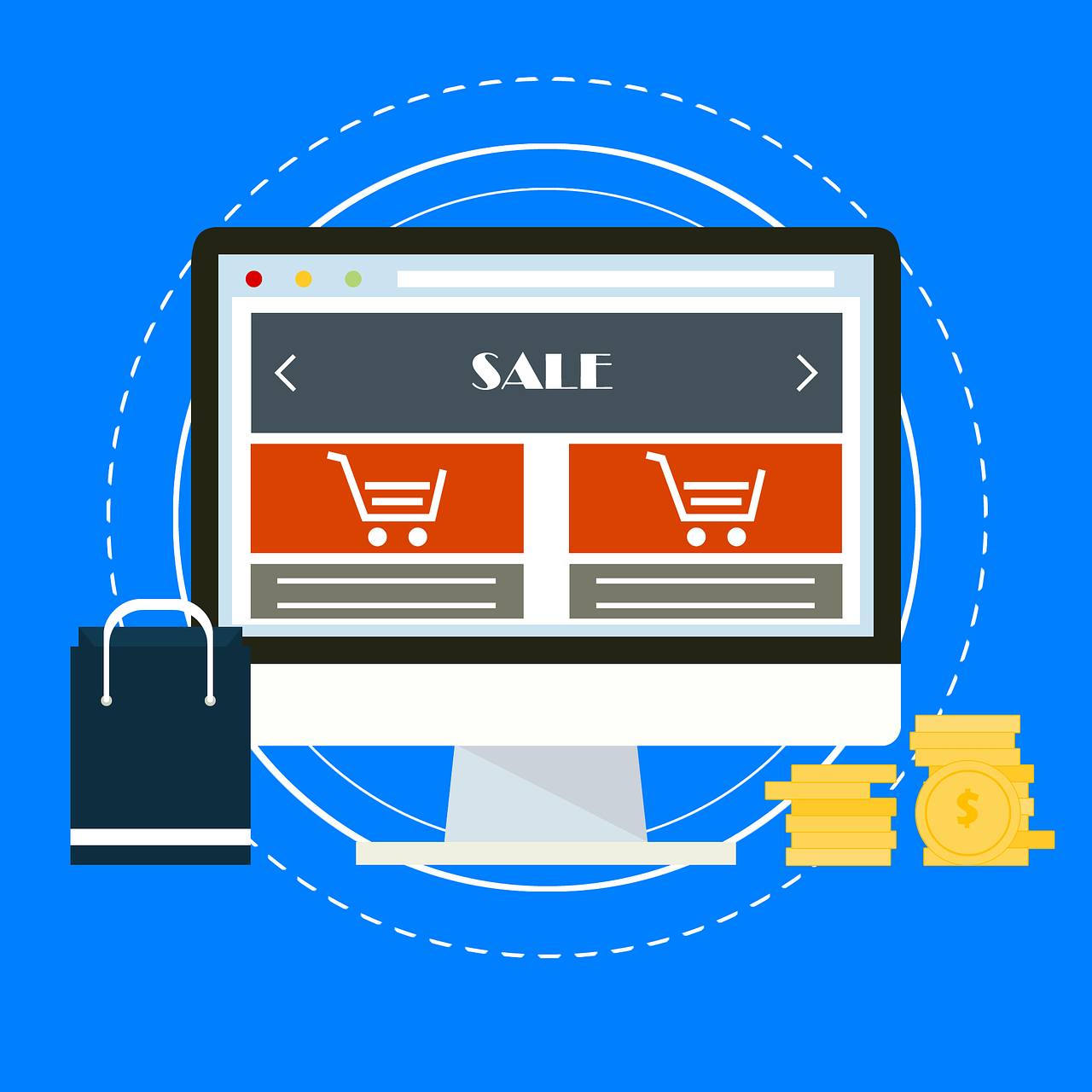
Wholesale Pricing Strategy
Set Wholesale Prices
You need to set wholesale prices that help your business and keep customers happy. First, look at your cost of goods sold, overhead, and the profit you want. This is the main part of any wholesale pricing strategy. Use a simple formula to figure out your price:
Wholesale Price = (Cost of Goods Sold + Overhead + Desired Profit Margin)
Let’s say you sell handmade candles. Your cost is $10, overhead is $2, and you want $2.50 profit. Your wholesale price would be $14.50. Always add shipping and handling costs, especially if prices change a lot.
Change prices if demand goes up or down, or if your competitors change theirs.
Give discounts for bigger orders to get more sales.
Set different prices for online stores or direct sales.
Tip: Try a wholesale price calculator. It helps you cover all your costs and make a profit.
Check your prices often. Wholesale prices can change quickly, so be ready to adjust. Many businesses raise prices on fancy items but keep basic ones cheap. This helps you stay competitive and keep your best customers.
Use Pricing Analytics
Pricing analytics help you make better choices. These tools look at your sales, inventory, and what your competitors do. You can find trends and know when to change your wholesale pricing.
Use price elasticity modeling to find the best price for each product.
Try dynamic pricing to change prices fast when demand or inventory changes.
Check your Competitive Price Index to see how your prices compare.
Data-driven pricing helps you make smart moves instead of guessing. You can see which products need a price change and which are doing well. Promotional lift analysis shows if discounts really help sales or just lower your profits. When you use analytics, you can keep profits up and stay competitive, even if wholesale prices rise.
Note: Match your pricing and promotions. This keeps your profits strong and brings customers back.
Market Research
Market research gives you the facts you need to set good wholesale prices. Use product research tools to track trends, what customers like, and what other businesses charge. This helps you find market gaps and change your wholesale pricing methods.
Study your competitors’ prices and see where you fit.
Look at how customers buy to find the right price.
Use market-based pricing to match what buyers expect.
Value-based pricing is another good way. Think about what your product is worth to your customer, not just what it costs you. This can help you charge more for items that solve big problems or are special.
Try this: Check your pricing every three months. Use both market-based and value-based pricing to keep up with changes.
When you use market research, analytics, and a clear wholesale pricing strategy, you can set prices that work for you and your customers. This helps you stay profitable, even when the market changes.
Customer-Specific Pricing

You do not need to give every customer the same price. With customer-specific pricing, you can make more money. This means you set prices for each customer. You look at how much they buy, if they are loyal, or if they have special needs. This helps you stay ahead of other businesses and keep your best customers happy.
Here are some ways to use customer-specific pricing:
Volume Discounts: Give lower prices to customers who buy a lot. If someone buys 1,000 units, they pay less than someone who buys 100. This helps you sell more and thanks your biggest buyers.
Loyalty Pricing: Give deals to customers who shop with you often. You can make a loyalty program or give discounts to repeat buyers. This keeps them coming back and builds trust.
Contract Pricing: Some customers want to keep the same price for a while. You can offer contract pricing to help them feel safe. This also helps you plan your sales and costs.
Custom Quotes: Sometimes, a customer wants something special. Maybe they need a big order or a unique product. You can give them a custom quote using your wholesale pricing methods. This shows you care and helps you get more sales.
Tip: Use a table or spreadsheet to track your customer-specific pricing. This keeps things simple and helps you avoid mistakes.
Customer Name | Order Size | Standard Price | Customer Price | Notes |
|---|---|---|---|---|
Store A | 1,200 | $10 | $9 | Volume discount |
Store B | 500 | $10 | $9.50 | Loyalty deal |
Store C | 2,000 | $10 | $8.75 | Contract price |
You can also use software to help with pricing. Many tools let you set rules for each customer. This makes it easy to change prices when your costs go up or down. You can update your wholesale pricing fast and keep your profits strong.
Customer-specific pricing is a great way for wholesalers to make money and stay competitive. You can reward your best customers and still cover your costs. When you use this pricing strategy, you show you understand what your customers want.
Always make sure your wholesale pricing matches your costs, your market, and your customer relationships. Try different wholesale pricing methods to see what works best. Stay flexible and check your prices often. This helps your business stay strong, even when things change.
Cost Reduction

Streamline Operations
You want your business to work better and faster. This is important when wholesale prices go up. Streamlining operations means finding ways to do things easier and cheaper. First, look at each step in your process. Are there jobs you can make automatic? Can you use software to help with orders or inventory? Many companies use data to find problems early and fix them.
Use data to spot slow parts in your work.
Try automation for things like orders or payments.
Train your team so everyone can help in different jobs.
A big company used data in their supply chain. They saved 15% on inventory and 10% on shipping. These savings let them buy more wholesale or try new products. Automation and AI help you make smart choices and save money. Even small changes, like smart sensors in your warehouse, can stop problems and lower energy bills.
Tip: Check your process every month. Small changes can save a lot over time.
Bulk Buying
Bulk buying helps you save money when you buy wholesale. If you buy more at once, you pay less for each item. This is called economies of scale. Suppliers often give discounts for big orders, so you spend less and earn more.
Here’s what happens when you buy wholesale in bulk:
You pay less for each item, so you can offer better prices.
Your shelves stay full, so you do not run out of top sellers.
You build better relationships with suppliers, which can mean faster shipping and better deals.
You get more control over prices, so you can react fast if the market changes.
You must watch your cash and storage, since bulk buying means spending more at first.
Look at this table to see how much you can save by buying wholesale in bulk:
Product Category | Average Savings from Bulk Buying | Example Savings (%) |
|---|---|---|
Overall Average | 27% | N/A |
Paper Towels | Above 50% | 63% |
Bottled Water | Above 50% | 58% |
Duracell AA Batteries | Above 50% | 54% |
Adult Multivitamins | Minimal Savings | 3% |
Other Products | Low Savings | ~8% |
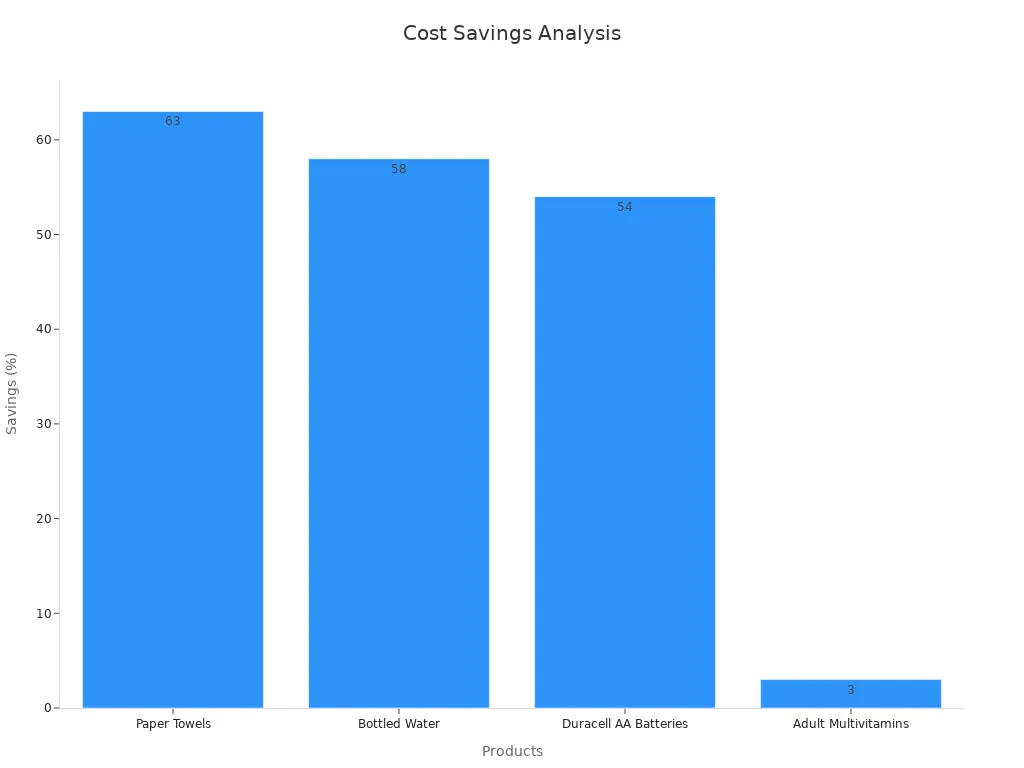
Bulk buying works best for items you sell a lot. If you buy wholesale for slow sellers, you might have too much stock. Always check your sales before making a big order.
Note: Bulk buying can cut costs, but you need a plan for storage and cash.
Lower-Cost Materials
You can sometimes save money by using cheaper materials. When buying wholesale, ask your supplier if they have similar but cheaper products. Many businesses do this when prices rise. For example, a company might use different packaging or a new supplier for materials.
Look for substitute products that still have good quality.
Test new materials before switching everything.
Talk to your supplier about cheaper options for buying wholesale.
Switching to lower-cost materials helps you keep prices steady for customers. It also lets you buy wholesale more often and keep profits up. Just make sure the new materials work well and keep customers happy.
Tip: Always check the total cost, not just the price per item. Sometimes, cheaper materials can cause problems and cost more later.
By making your business run smoother, buying in bulk, and picking lower-cost materials, you can keep your wholesale business strong. These steps help you save money, stay flexible, and handle higher prices with confidence.

Reduce Overhead
Overhead costs can sneak up on you. These are the bills you pay just to keep your business running. Rent, utilities, insurance, and office supplies all count as overhead. When wholesale prices go up, cutting overhead can help you stay profitable.
Start by making a list of every overhead expense. You might be surprised by how much you spend on things you do not need. Here are some easy ways to cut overhead:
Go digital. Switch from paper to digital invoices and records. You save money on paper, ink, and storage. Plus, you find files faster.
Negotiate with service providers. Call your landlord, internet provider, or insurance company. Ask for better rates or discounts. Many companies will work with you if you ask.
Cut unused subscriptions. Check your bank statements for software or services you do not use. Cancel them right away.
Share space or resources. If you have extra office or warehouse space, rent it out. You can also share equipment with other businesses.
Reduce energy use. Turn off lights and machines when you do not need them. Use energy-saving bulbs and smart thermostats.
Tip: Set a reminder to review your overhead costs every three months. Small changes add up over time.
You can also use a simple table to track your savings:
Overhead Item | Old Cost/Month | New Cost/Month | Monthly Savings |
|---|---|---|---|
Office Rent | $2,000 | $1,800 | $200 |
Internet Service | $150 | $120 | $30 |
Software Licenses | $300 | $200 | $100 |
Utilities | $400 | $350 | $50 |
Total Savings | $380 |
Cutting overhead does not mean you have to sacrifice quality. You just need to get creative. Ask your team for ideas. Sometimes, the best savings come from the people who use these services every day.
You can also try outsourcing tasks like payroll or cleaning. This often costs less than hiring full-time staff. If you use freelancers or part-time workers, you only pay for what you need.
Remember, every dollar you save on overhead goes straight to your bottom line. Lower overhead gives you more room to handle high wholesale prices. Stay alert, keep looking for savings, and celebrate your wins—no matter how small. Every bit helps your business stay strong.
Adjust Retail Pricing
Update Retail Prices
It can feel scary to raise prices, but sometimes you must. When wholesale costs rise, you need to change your retail prices. This helps protect your business. First, check your costs and profit margins. If profits are getting smaller, you need to do something.
Here are some steps to help you change prices:
Check your costs every week. Wholesale prices can change quickly.
Look at your prices and compare them to other stores. Make sure you are not too high or too low.
Raise prices first on products that cost you more. Try to keep favorite items affordable if you can.
Use this easy formula for new prices:
New Retail Price = Wholesale Cost + Overhead + Desired ProfitTell your customers about the changes. Be honest and clear with them.
You do not have to raise prices on everything at once. Focus on the things that cost you the most now. This helps your store stay fair and keeps your best customers coming back.
Dynamic Pricing Tools
Dynamic pricing tools help you keep up when things change fast. These tools use data to find the best price for each product. They look at demand, what other stores charge, and your profit goals. You can change prices every day or even every hour.
Look at this table to see how dynamic pricing helps:
Metric Category | Key Indicators | Target Improvements |
|---|---|---|
Financial Performance | Profit margins, Revenue growth | |
Inventory Health | Stock turnover, Holding costs | 9.6% reduction |
Customer Metrics | Net Promoter Score (NPS), Lifetime value | 20% brand value boost |
Sales Performance | Conversion rates, Average order value | Monitor daily fluctuations |
Dynamic pricing lets you:
Change prices fast when the market changes.
Keep your profit margins safe.
Sell slow products more quickly.
Compete with other stores.
Many stores use dynamic pricing to keep some prices low and others higher. For example, a store might keep basic items cheap to bring in shoppers. Then, they make more money on special products. This helps keep your profits strong.
To use dynamic pricing well, you need good data. Get tools that track sales, stock, and what other stores charge. Test your prices often and change them if needed. AI and real-time data help you spot trends and set the best price.
Here are some reasons dynamic pricing is good:
You can change prices fast when demand changes.
You get ahead of your competition.
You use data to make smart choices.
Communicate Value
When you change prices, you need to talk to your customers. People want to know why prices are higher. If you explain, they will trust you more. Good communication helps keep customers loyal.
Did you know most customers care most about their experience? If you show them why your prices changed, they will notice. Customers who feel valued are more likely to buy again.
Try these ideas to show value:
Tell stories about your products. Share details about quality, where you get them, or what makes them special.
Explain why prices went up. Be honest about higher costs or better materials.
Give loyalty rewards or special deals to thank repeat buyers.
Make your messages personal. Customers like feeling special.
It is important to manage what customers expect. If you keep your promises and give great service, people will stay with you even if prices rise. Keeping a customer costs less than finding a new one. Even a small increase in customer loyalty can raise your profits a lot.
When you focus on value and talk clearly, your pricing plan gets stronger. You build trust, keep your brand strong, and make sure your prices work for everyone.
Manage Expectations
Raising your retail prices can feel tough. You might worry about how your customers will react. The truth is, you can’t control every reaction, but you can guide how people see your business. Managing expectations helps you keep trust and loyalty, even when prices go up.
Start by being honest. If you need to raise prices, let your customers know why. People like to feel included. When you share your reasons, you show respect. You also help them understand that you care about their experience.
Tip: Use simple language when you talk about price changes. Avoid business jargon. Speak like you would to a friend.
Here are some ways you can manage expectations:
Give advance notice. Tell your customers before you change prices. This gives them time to adjust. You can use email, social media, or signs in your store.
Explain the reason. Share that your costs have gone up. You can mention higher wholesale prices, better materials, or improved service.
Highlight the value. Remind customers what makes your products special. Maybe you offer great customer service, fast shipping, or unique items.
Offer options. If possible, suggest lower-priced alternatives or bundles. This helps customers feel like they still have choices.
Stay positive. Focus on what you can do for your customers, not just what you can’t.
You might get questions or even complaints. That’s normal. Listen to your customers. Thank them for their feedback. Sometimes, just showing that you care makes a big difference.
Here’s a quick table to help you respond to common questions:
Customer Question | How You Can Respond |
|---|---|
“Why did the price go up?” | “Our costs from suppliers increased, but we’re working hard to keep quality high.” |
“Will prices go up again soon?” | “We review prices often and will always let you know ahead of time.” |
“Are there any deals left?” | “We still have special offers and bundles to help you save.” |
Note: Stay calm and friendly, even if someone gets upset. Your attitude can turn a tough conversation into a positive one.
Managing expectations is not just about talking. It’s about showing you care. Keep your promises. Deliver great service. When you do these things, your customers will trust you—even when prices change.
Remember, you set the tone for your business. When you handle price changes with honesty and care, you build stronger relationships. Your customers will notice, and many will stick with you for the long run.
Diversify & Adapt
Private Label
Private label products can help you stand out in the wholesale market. When you create your own brand, you control the look, quality, and price. This gives you more power over your profit margin. You do not have to rely on big brands or pay extra for their names. Instead, you work with a manufacturer to make products just for you.
Many businesses use this strategy to offer something unique. For example, you might sell private label snacks, cleaning supplies, or clothing. You can set your own wholesale prices and adjust them as costs change. This helps you stay flexible when the market shifts.
Tip: Start small with one or two private label items. Test them with your best customers. If they sell well, add more.
Private label products also let you respond to trends quickly. If you see a new style or flavor getting popular, you can launch your own version. This keeps your business fresh and helps you keep a strong profit margin.
Direct Sourcing
Direct sourcing means you buy straight from the manufacturer, not through a middleman. This can lower your costs and give you better control over quality. You can talk directly with the factory about what you need. This makes it easier to get custom products or special packaging.
When you use direct sourcing, you often get better wholesale prices. You can also build a closer relationship with your supplier. This helps you solve problems faster and get better deals. Many businesses use this strategy to boost their profit margin and stay ahead of the competition.
You might need to order larger amounts when you source directly. Make sure you have enough storage and cash flow. Start with your best-selling items. If it works, expand to other products.
Note: Always check the factory’s reputation before you place a big order. Ask for samples and visit if you can.
Selective Wholesale
Selective wholesale is a smart way to manage risk and keep your business strong. You do not have to sell every product to every customer. Instead, you pick the best products and focus on your top buyers. This strategy helps you keep your inventory lean and your profit margin healthy.
A great example is Costco. They use selective wholesale by offering a limited number of products but selling them in large amounts. This keeps their prices low and their sales high. Research shows that cutting slow sellers and focusing on winners can boost your profits and lower your risk.
You can use market research to decide which products to keep. Look at your sales data and see what sells best. Drop items that do not move or have a weak profit margin. This lets you put your energy into products that help your business grow.
Review your product list every month.
Focus on high-demand, high-margin items.
Offer special deals to your best customers.
By using private label, direct sourcing, and selective wholesale, you can adapt to high wholesale prices. These strategies help you stay flexible, protect your profit margin, and keep your business moving forward.
Expand Offerings
You might feel stuck when wholesale prices go up. One way to fight back is to expand your offerings. This means you add new products or services to your business. You give your customers more choices. You also open new ways to make money.
Why should you expand your offerings?
When you offer more, you attract new customers. You also keep your current customers coming back. People like to shop where they can find everything they need. If you only sell a few things, they might look somewhere else.
Here are some smart ways to expand your offerings:
Add Related Products:
Look at what you already sell. Think about what goes well with those items. For example, if you sell coffee beans, you can add mugs, filters, or snacks. If you sell clothing, try adding hats, belts, or jewelry.Offer Bundles:
Put two or three products together and sell them as a bundle. Customers love deals. Bundles help you move slow-selling items and boost your average sale.Try Seasonal or Trendy Items:
Watch for trends or holidays. Add products that fit the season. For example, sell sunscreen in summer or cozy blankets in winter. You can also try trending items you see online.Launch Services:
You do not have to stick to products. Offer services like gift wrapping, delivery, or product repair. Services can set you apart from other sellers.Test New Categories:
Start small with a few items in a new category. See how your customers react. If they like it, add more. If not, try something else.
Tip: Ask your customers what they want to see in your store. You can use a quick survey or just talk to them. Their answers might surprise you!
Here’s a simple table to help you brainstorm:
Current Product | Possible Add-On | Service Idea |
|---|---|---|
Coffee Beans | Coffee Mugs | Coffee Subscription |
T-Shirts | Hats | Custom Printing |
Phone Cases | Screen Protectors | Phone Setup Help |
Expanding your offerings does not mean you need to buy a lot of new stock right away. You can start with small orders or even dropship new items. Watch your sales data. Keep what works and drop what does not.
When you give your customers more choices, you build a stronger business. You also protect yourself from sudden price changes. If one product gets too expensive, you have others to fall back on. Stay curious, keep testing, and watch your business grow!
If wholesale prices seem too high, do something quickly. First, talk to your suppliers and see if you can change your orders. Focus on selling products that give you the most profit. Keep checking your prices and how you work with suppliers. Use data to find patterns and help you decide what to do. Many companies now use dashboards and alerts to watch suppliers and costs. Stay ready to change, tell your customers why your products are valuable, and always look for new ideas. If you keep trying and stay open, you can get through any problem.
FAQ
What should I do first if wholesale prices go up suddenly?
Start by checking your costs and profit margins. Look at your best-selling products. Talk to your suppliers right away. Quick action helps you avoid bigger problems later.
Can I switch suppliers if prices are too high?
Yes, you can. Search for new suppliers online or ask for recommendations. Always check reviews and order samples before making a big change.
How do I explain price increases to my customers?
Be honest and clear. Tell your customers that your costs have gone up. Let them know you still care about quality and service.
Is dropshipping a good idea when wholesale prices rise?
Dropshipping can help you lower risk. You do not need to buy lots of stock. Test it with a few products first to see if it works for your business.
What if my profit margin gets too low?
Focus on selling high-margin products. Cut costs where you can. Use dynamic pricing tools to help you adjust prices quickly.
How often should I review my pricing strategy?
Check your prices at least every three months. If costs change fast, review them more often. Use sales data to help you decide when to make changes.
Can I offer discounts when wholesale prices are high?
You can, but be careful. Only offer discounts on products with a strong profit margin. Use bundles or loyalty rewards to give value without hurting your profits.

TangBuy: A Smarter Way to Dropship in 2025
If you're looking to stay competitive with dropshipping in 2025, speed and trend-awareness are key. TangBuy helps you stay ahead with real-time product trends, fast fulfilment, and factory-direct sourcing. With over 1 million ready-to-ship items, 24-hour order processing, and seamless Shopify integration, TangBuy makes it easier to test, scale, and succeed in today's fast-moving eCommerce landscape.
See Also
Affordable Products That Deliver High Profits For 2025
Profitable Dropshipping Concepts To Try In 2025
Leading Instagram Gold-Plated Jewelry Trends Boosting Wholesale
